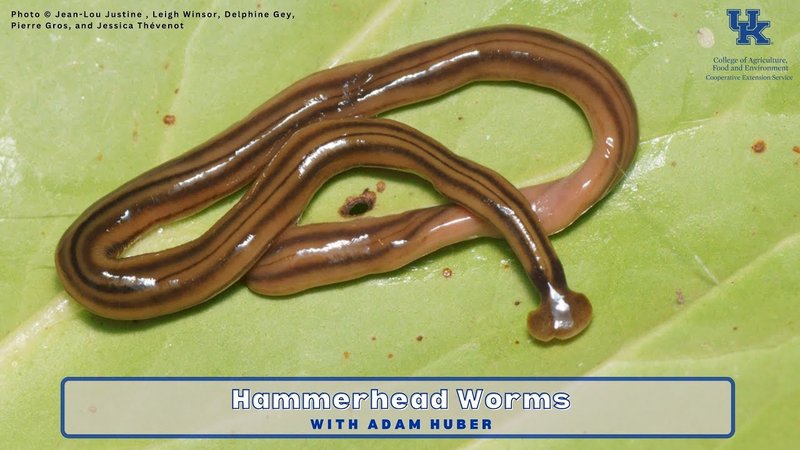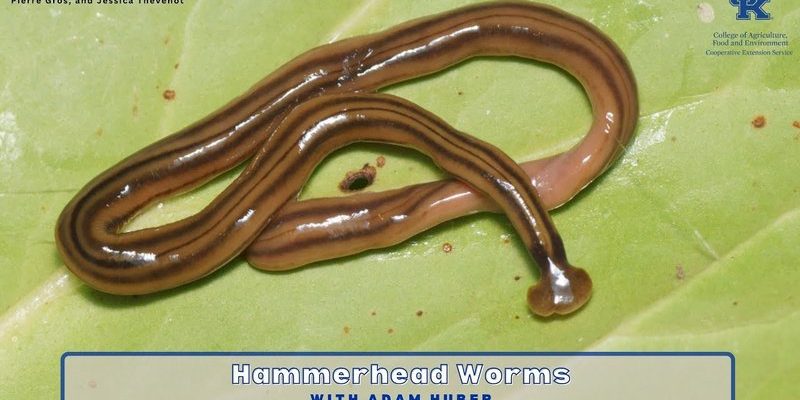
Picture this: you’re tending to your garden, enjoying the warm sun and the fresh smell of soil. Suddenly, you spot a sleek, flat worm with a hammer-shaped head slithering through the earth. This is no ordinary worm—it’s a hammerhead worm, and it has a knack for multiplying. They’re like the unwelcome guest at a party who keeps bringing friends along. Knowing how they reproduce helps you anticipate their presence and deal with them effectively, ensuring your garden stays healthy.
What Exactly Are Hammerhead Worms?
You might be wondering what makes hammerhead worms unique. These *Bipalium* species, often found in tropical and subtropical regions, don’t belong to the earthworm family. Instead, they’re part of a group known for their striking appearance and predatory habits. Their flat, ribbon-like bodies and distinctive hammer-shaped heads make them stand out.
Hammerhead worms can be colorful, often sporting shades of brown, gray, or even yellow. They can grow quite long—some reaching up to 12 inches! More importantly, they’re known for their appetite for other soil-dwelling creatures, including earthworms. This predation can significantly impact soil health and fertility, which is a major concern for gardeners.
How Do Hammerhead Worms Reproduce?
Let me explain hammerhead worm reproduction. These worms are known for their fascinating and somewhat unusual method of reproducing. They can reproduce both sexually and asexually, which makes them quite prolific. In sexual reproduction, male and female worms come together to exchange sperm, leading to fertilization. This process often occurs in damp conditions, where they’ll engage in a sort of mating dance.
In a remarkable twist, hammerhead worms can also reproduce asexually through a process called *fragmentation*. This means if a hammerhead worm gets cut in half, each half can regenerate into a new worm! This ability not only makes them resilient but also amplifies their population quickly. So, if you try to remove them from your garden physically, be prepared—more could emerge from the pieces you left behind.
What’s the Lifecycle Like?
Now, let’s chat about the lifecycle of hammerhead worms. After mating, the female lays eggs in a cocoon, which often looks like a gelatinous mass. Each cocoon can contain multiple eggs, depending on the species and environmental conditions. These eggs usually hatch within a few weeks, giving rise to young hammerhead worms that are small but already resemble miniatures of their parents.
Young hammerhead worms will feed on soil-dwelling organisms as they grow, and within a few months, they reach maturity. Since they can reproduce quickly, you might find yourself with a significant number of them if conditions are right.
Why Should Gardeners Be Concerned?
You might be curious why all of this matters to your gardening venture. Well, hammerhead worms can be detrimental to your garden. Their diet primarily consists of earthworms, which are essential for maintaining healthy soil. Earthworms help aerate the soil, improve drainage, and enhance nutrient content. By preying on them, hammerhead worms can disrupt these processes, leading to poor soil health and reduced plant vitality.
Furthermore, hammerhead worms can be challenging to control, especially since they can quickly multiply through fragmentation. As a gardener, you must be proactive and informed about their habits and lifecycle to effectively manage their population before they wreak havoc in your garden.
How Can You Control Hammerhead Worm Populations?
You might be feeling a bit overwhelmed by the thought of dealing with hammerhead worms. But don’t worry; there are ways to manage their presence in your garden. Here are some effective strategies:
- Hand Removal: If you see them, you can pick them up and dispose of them. Just be cautious, as they can regenerate if you cut them. Instead, try to remove them whole.
- Environmental Management: Since hammerhead worms thrive in moist, humid conditions, reducing excess moisture in your garden can help deter them. This doesn’t mean you should neglect your plants’ needs—just keep the soil from becoming soggy.
- Natural Predators: Introducing predators like birds or other beneficial insects can help keep worm numbers in check. Just be mindful that they won’t eliminate the worms entirely.
Being proactive and consistent in your approach will help manage the population without harming other beneficial organisms in your garden.
What Should You Avoid When Dealing with Hammerhead Worms?
When it comes to managing hammerhead worms, there are a few pitfalls to avoid. Here’s what you need to keep in mind:
- Using Chemicals: Heavy chemical pesticides can harm beneficial insects alongside worms. Opt for more natural solutions whenever possible.
- Ignoring the Problem: It can be tempting to think, “They’ll go away on their own.” But hammerhead worms can quickly take over if left unchecked. Regular monitoring is key.
- Relying on Just One Method: A single strategy might not work for everyone. Combining different approaches often yields the best results.
By being aware of these challenges, you can tackle hammerhead worms more effectively and keep your garden flourishing.
Final Thoughts on Hammerhead Worm Reproduction
In the end, understanding hammerhead worm reproduction is crucial for any gardener who wants to maintain a healthy garden. Their fascinating yet formidable ways of multiplying can make them daunting foes, but with the right knowledge and strategies, you can keep their numbers manageable. So, the next time you encounter one of these flat, hammer-headed beings, you’ll know exactly what you’re up against—and how to handle it.
Just remember: knowledge is power! The more you know about these creatures, the better equipped you’ll be to protect your garden sanctuary. Happy gardening!

